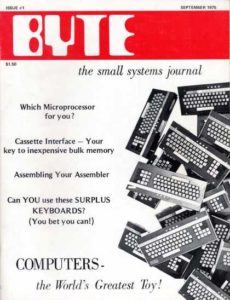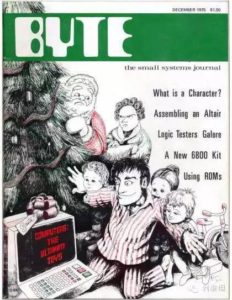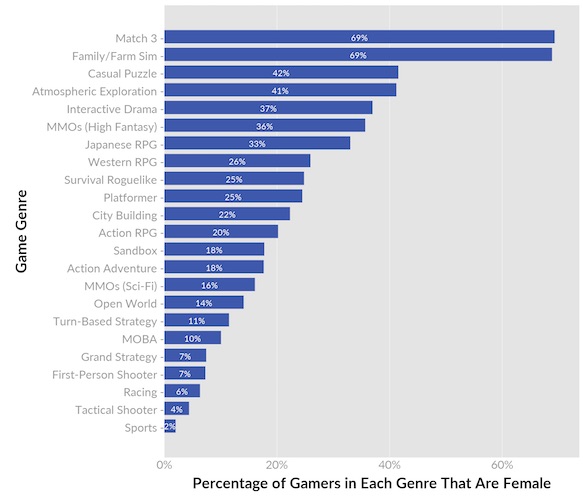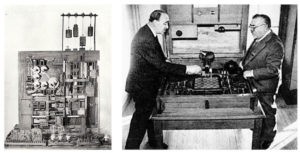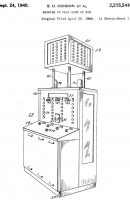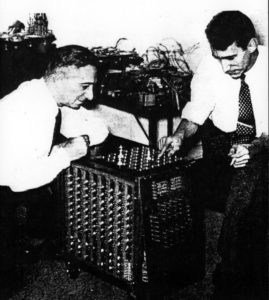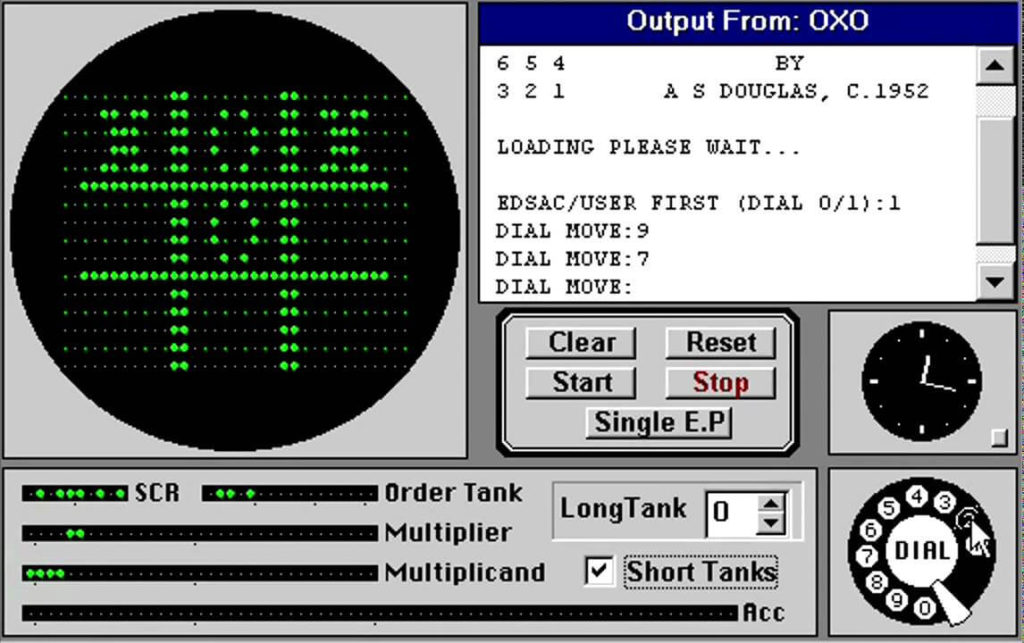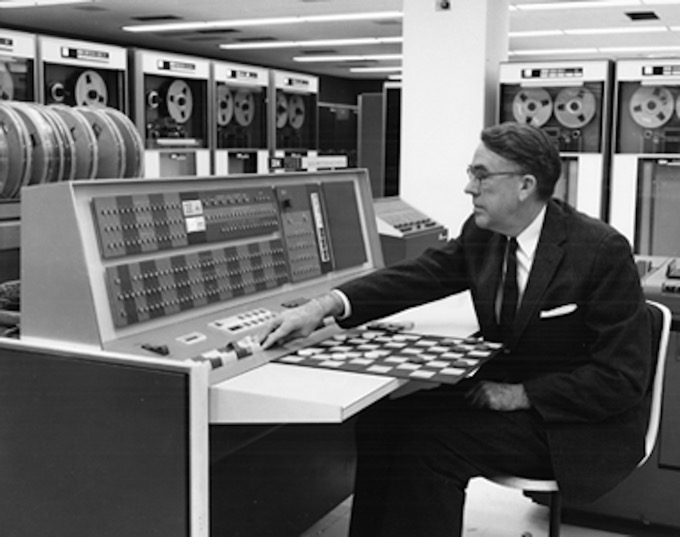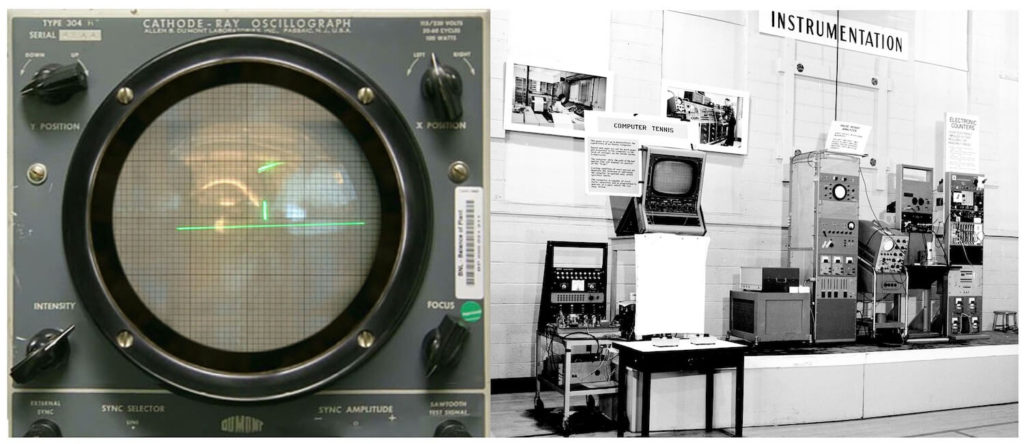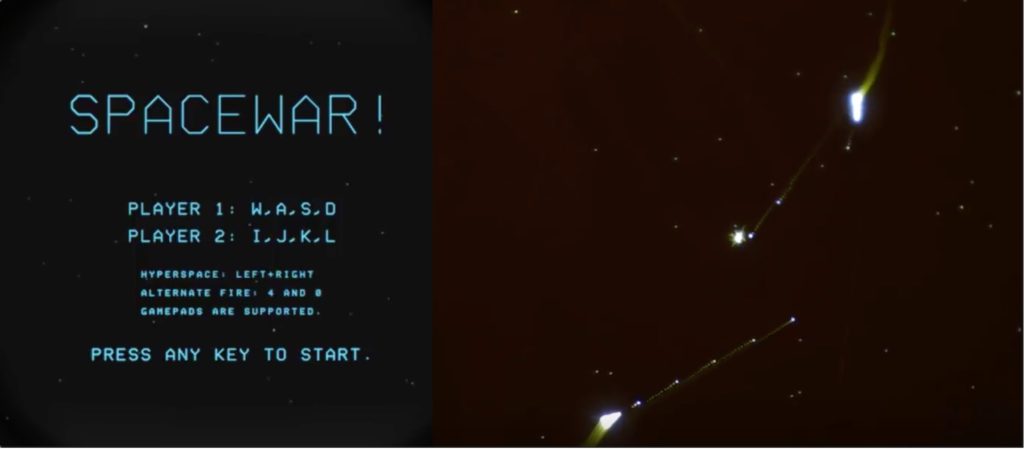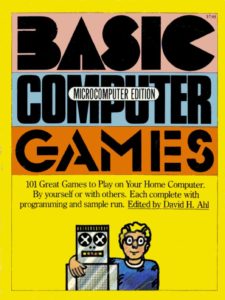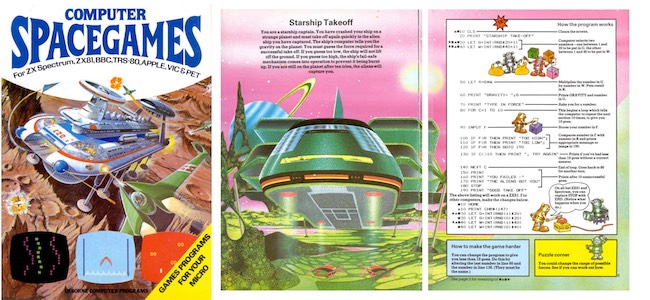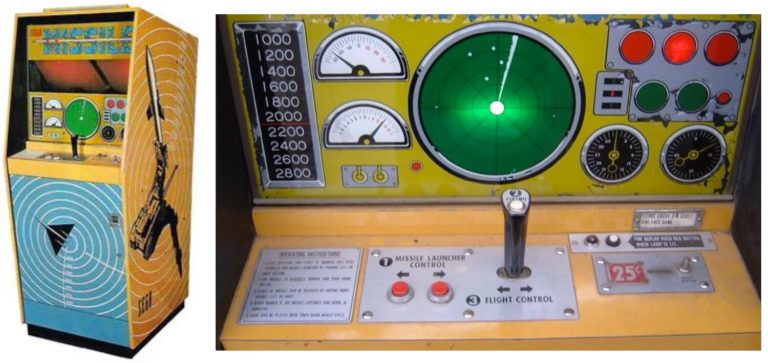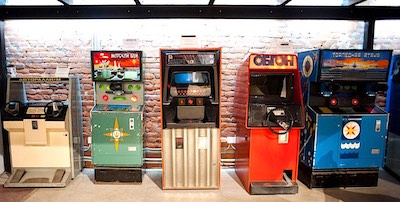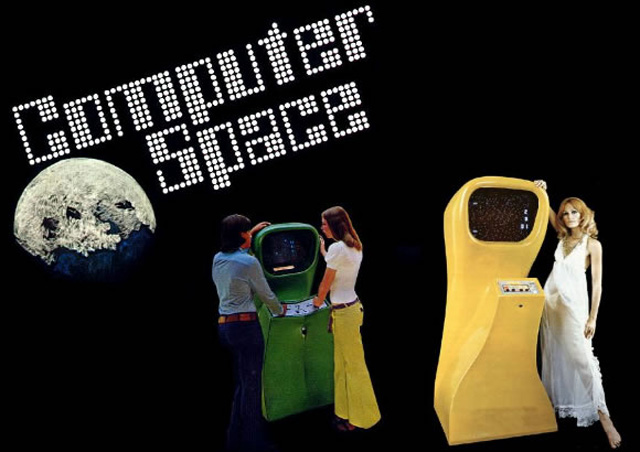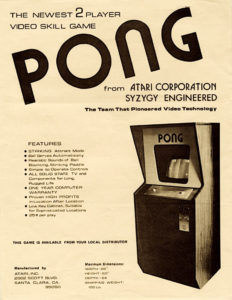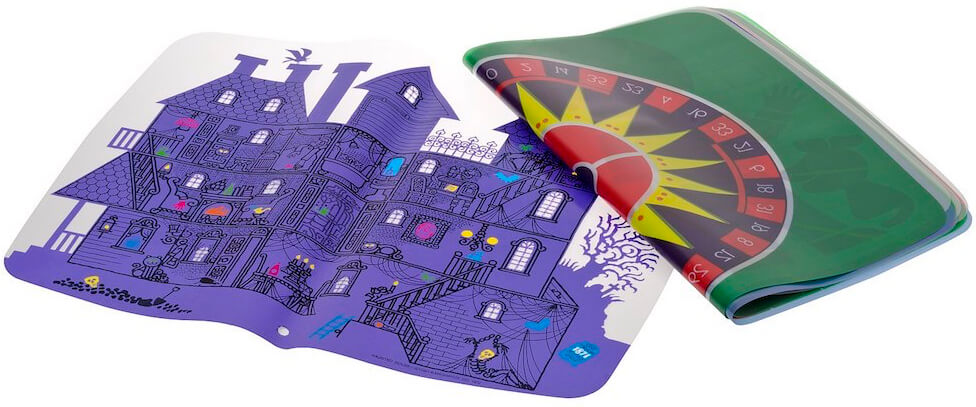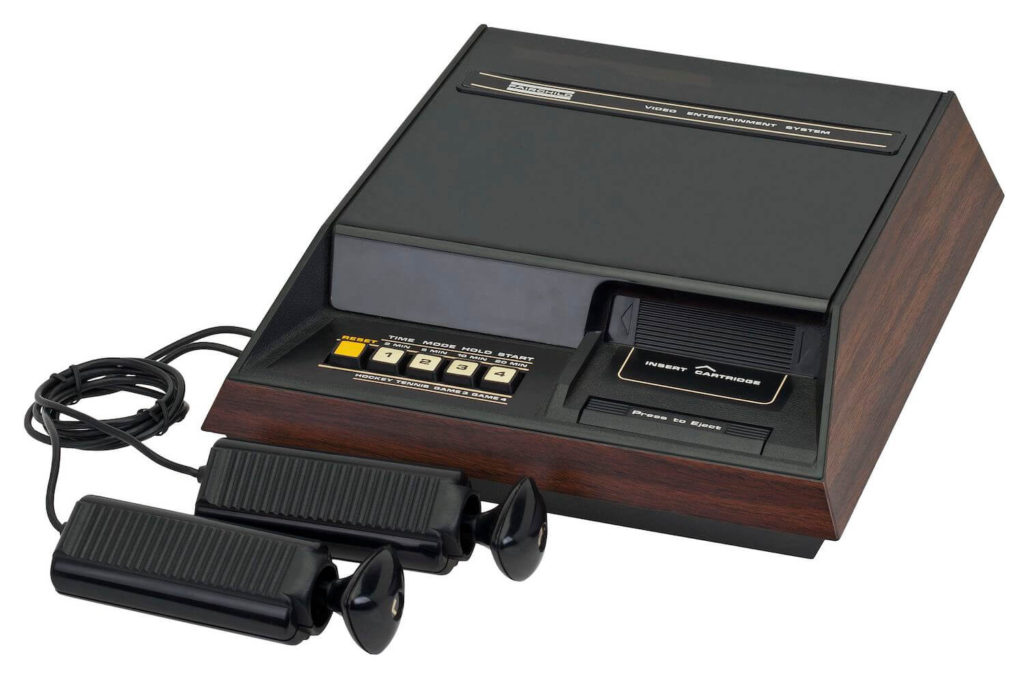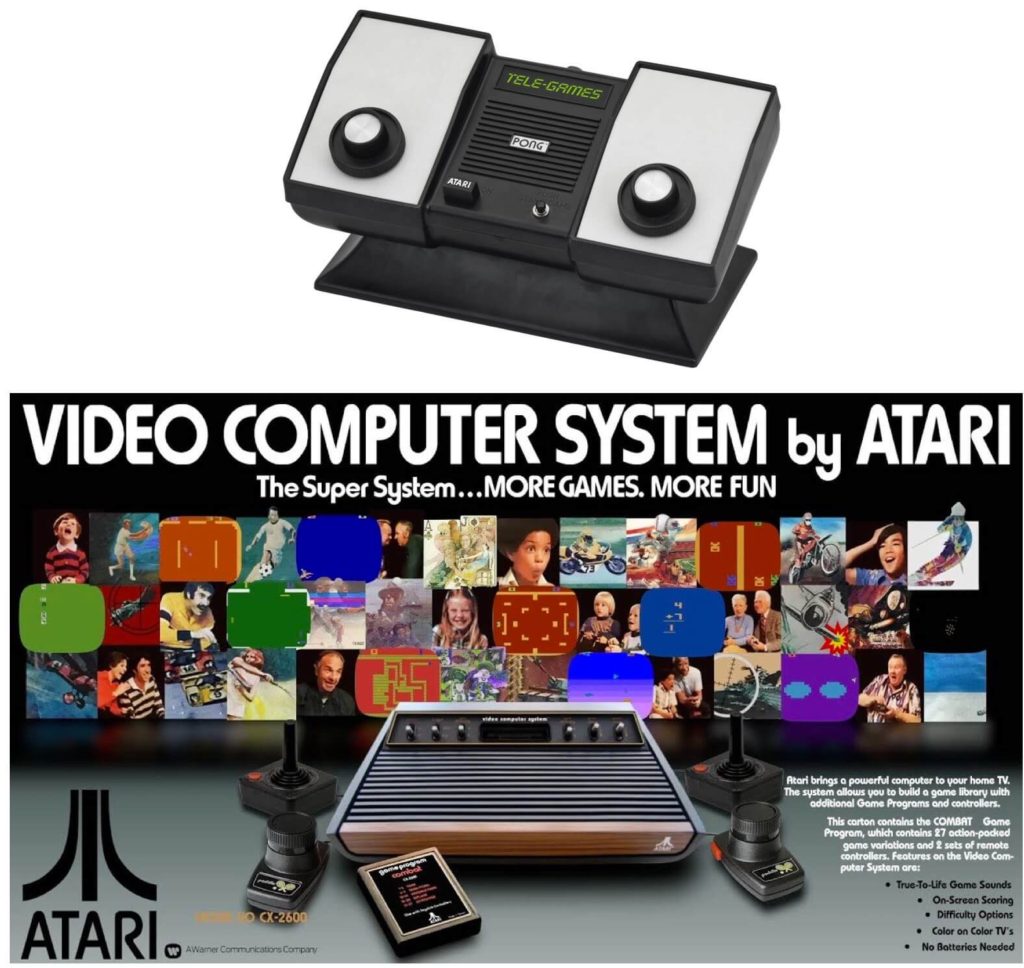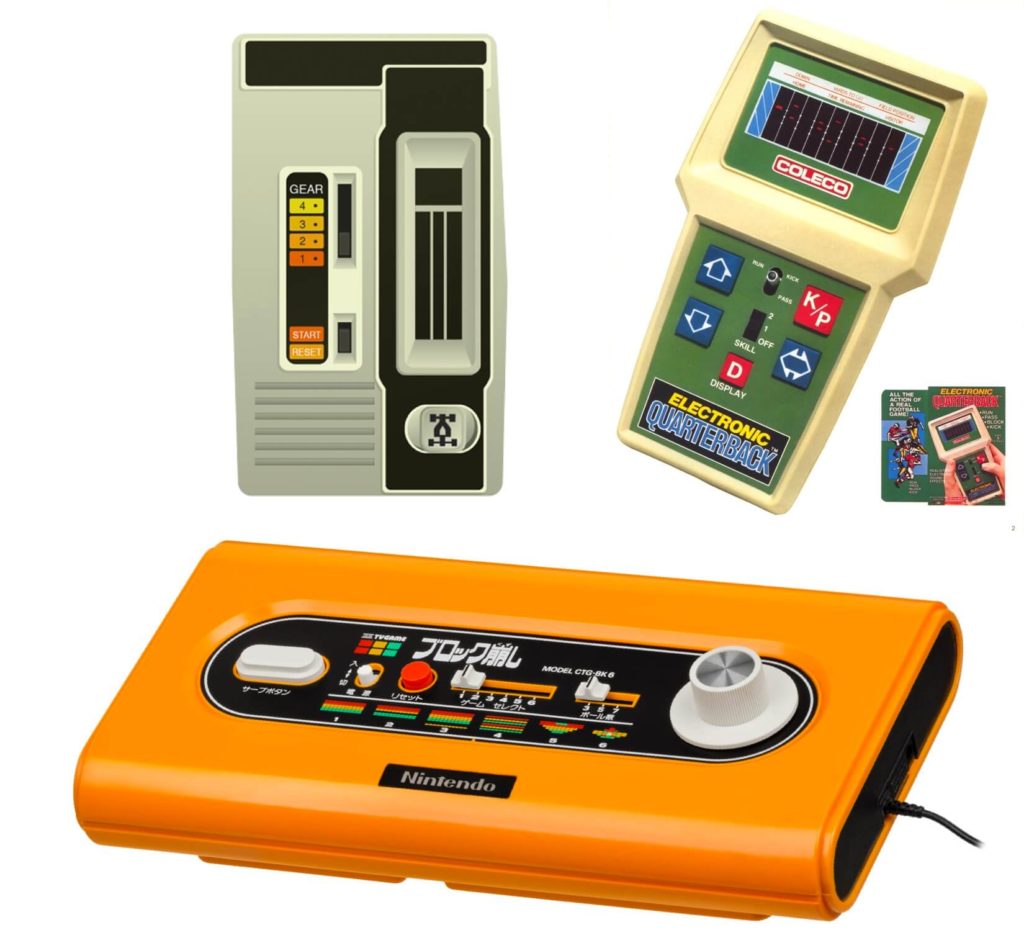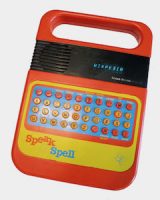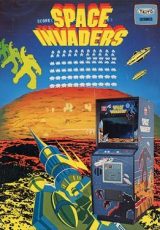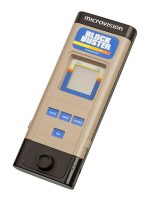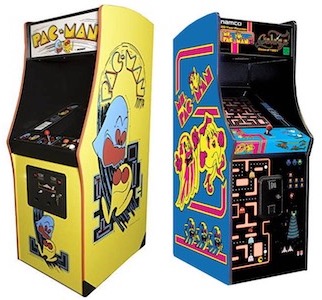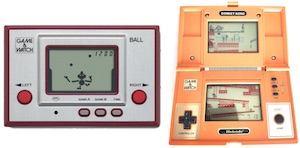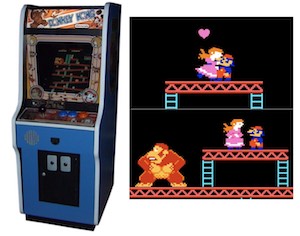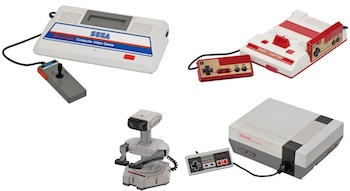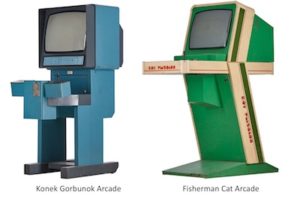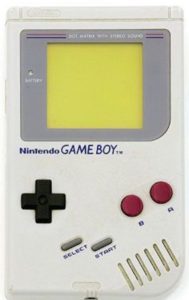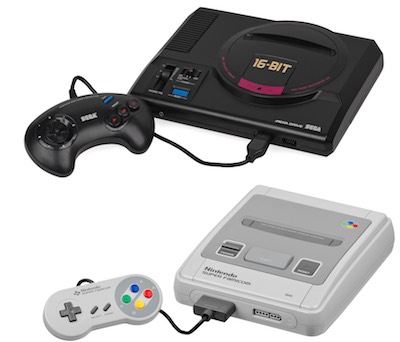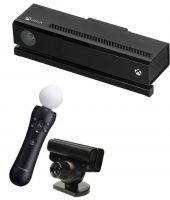Playing With Computers.
October 2018. by Vladimir Esaulov
People love to play games. Games have existed all over the world since ancient times. They are a fundamental part of the learning process for children and remain a part of their lives as a pass- time and a means of socialising. When the first PC’s appeared Byte magazine had titled: “Computers: the World’s Greatest Toy”. This is symbolised on Mark Tinney’s Byte cover drawing of Christmas where the father obviously does not want any of the family to touch and play with the new PC. Computers rendered possible the appearance of numerous games from the very beginning at the time of big and unwieldy mainframes and games have influenced PC development especially in the realm of graphics hardware and specialised software. Computer games have increasingly become a significant aspect of our contemporary culture. They are a source of amusement, a source of work as games creator, stimulate technology developments and some universities now offer courses in games development. They can also play an adverse role on some people. Here we first look briefly at the way games developed and then give a brief timeline of computer games.
Computer Games Development.
Since the appearance of computer games, a number of interrelated changes occurred, that have changed the way games are developed, how they are played, who plays them and how all this transformed the home-brew game development pass-time into a multibillion industry, with game production having strong similarities to movie production.
Hardware. The development of more powerful and faster central processing units, graphics processors, larger memories, as well as faster, larger and more reliable storage have had a huge impact on what was possible in computer games and has enabled production of more sophisticated games with very realistic 3D graphics capabilities. Internet connectivity has allowed development of games for distant players.
Input/output devices.The earliest computer games were played using keyboard input and then using simple consoles with rotating knobs and buttons and mouse and rudimentary joysticks. Today’s game controllers can have multiple joysticks, numerous buttons and a control screen. Since Sega’s pioneering 1993 Activator, devices that follow movement appeared, like the Wii controllers of Nintendo or the Kinect system of Microsoft. Obviously these had an influence on how games are played and developed. A major evolution concerns graphics both in the way the drawing of images on the screen is performed and the improvement of graphic controllers, available graphics memory and displays. Also sound systems progressed.
Software toolboxes. Initially a game creator would write every line of code often including assembly language and had to draw the artwork pixel by pixel. Today, following much progress in graphics software, there exist extensive game engines and other middleware packages that simplify immensely creation of sophisticated games with extensive special effects.
Player Demographics.Games were primarily played by males, but this has considerably changed in recent years and the number of female players has grown considerably. According to Statista 15 percent of global gamers are women between the ages of 21 and 35 years. This statistics varies from source to source and the percentage changes with type of games played. It could be said that this trend was kick-started by Japanese Namco’s creation of the arcade game Ms Pac-Man two years after their release of Pac-Man (see below). Games are now accessible to very young children and attract very old players. As a result, the types of computer games available has evolved.
Player Demographics.Games were primarily played by males, but this has considerably changed in recent years and the number of female players has grown considerably. According to Statista 15 percent of global gamers are women between the ages of 21 and 35 years. This statistics varies from source to source (reaching almost 50%) and the percentage changes with type of games played. It could be said that this trend was kick-started by Japanese Namco’s creation of the arcade game Ms Pac-Man two years after their release of Pac-Man (see below). Games are now accessible to very young children and attract very old players. As a result, the types of computer games available has evolved.
A general analysis of Indian gamers may be found in the KPMG report of 2017: Online Gaming in India.
The Dawn of Computer Games: A brief timeline.
Electronic games started appearing much before our common PCs and cell phones. We look at the early history, but first a look into the still older past.
1770. Hungarian inventor Wolfgang von Kempelen created a chess-playing automaton called The Turk whose human-like playing qualities amazed audiences across Europe and America. The source of its playing strength was a human chess player hidden inside.
1910s-1950s. The beginnings.
1912. Torres Quevedo‘s chess automaton and the first step to AI. Spanish engineer Leonardo Torres Quevedo, inventor of the Telekino radio control, designed what could be considered the first aritificial intelligence device: an electromechanical chess automaton. He called it the: El Ajedrecista (The Chessplayer). The machine played an endgame with the white king and rook, and the opponent with the black king. The Ajedrecista could achieve checkmate from any initial position in a few moves. The functioning of this system was based on principles of commutation systems, described by Torres Quevedo in his Report on Automatics. He designed a second system in 1920. The first machine was presented in Paris in 1914.
1940. Edward U. Condon in the US, designed a relay computer for the Westinghouse display at the World’s Fair that played the game Nim in which players try to avoid picking up the last matchstick (US patent 2,215,544). Thousands of people played it, and the computer won most of the games.
1947-48. PhysicistsThomas T. Goldsmith Jr. and Estle Ray Mann of DuMont Laboratories (US) were awarded a patent for a “cathode ray tube amusement device.” Their game used an oscilloscope (cathode ray tube-CRT) display and analog electronics (not a computer). Players could adjust the trajectory of the CRT so that it could hit “targets” overlaid on the screen. The games is a source of ongoing arguments whether it should or should not be called a “video game”.
1948. There were no computers around, but Alan Turing in England with David Champernowne wrote the instructions that would enable a future machine to play chess. They named the program Turochamp, but it became known as “Turing’s paper machine”. Turing’s goal was to make a machine which would play a reasonably good game of chess, i.e. which, confronted with an ordinary chess position, would after two or three minutes of calculation, indicate a passably good legal move. At the time a rival chess-playing program called Machiavelli was being developed by his colleagues Donald Michie and Shaun Wylie, apparently partly inspired by the work on Turochamp. In the 1950’s Turing started programming Turochamp on a Ferranti Mark 1 computer at the University of Manchester, but never finished because of his death. Turing wrote down his ideas about computer chess in the “Faster than thought” paper. These ideas were not implemented till 2004 when a programming team at the ChessBase software company tried to create a chess engine based on Turing’s algorithms. Read about this @ ChessBase. World chess master Gary Kasparov played against this Turochamp re-creation.
1950. In the US Claude Shannon wrote guidelines for programming a chess-playing computer in the article, “Programming a Computer for Playing Chess” (Phylosophical Magazine, 41, 1950, pp256-275). Claude Shannon said of programming a computer to play chess that “Although of no practical importance, the question is of theoretical interest, and it is hoped that…this problem will act as a wedge in attacking other problems…of greater significance.” The paper discussed how a position might be evaluated and how a game tree might be searched. This paper also includes a discussion of what came to be known as ‘the Shannon number” (or “the game tree complexity of chess”) the number of possible chess games that can be played. That number is based on Shannon’s calculation on a logical approximation that each game has an average of 40 moves and each move a player chooses between 30 possible moves. That makes a total of 10120 possible games. Shanon also built a chess playing relay computer an automaton that handled six chess pieces and helped analysing chess moves.
1951. Dr. Dietrich Prinz, a follower of Turing who led the development of the Ferranti Mark 1, created a limited chess program to run on Mark 1 (Prinz, D. G. ‘Robot Chess’, Research, vol. 5 (1952), pp. 261-266. and B.Jack Copeland and Diane Proudfoot, Alan Turing: Father of the Modern Computer). Prinz’s program first ran in November 1951.
1951-52. Christopher Strachey at the National Physical Laboratory (UK) started developing a Draughts Player program for the Pilot Model ACE in 1951. Along with Turing’s “paper chess” it was the first AI program to use a heuristic search method. It finally ran on the Ferranti Mark I in mid-1952. The essentials of Strachey’s program were taken over by Arthur Samuel in the U.S. (see below).
1952. A Cambridge University PhD student Alexander Douglas designed a version of Tic-Tac-Toe /Naughts and Crosses, called OXO, played on Cambridge’s EDSAC computer. He used a rotary telephone dial to enter moves. The game board was displayed on EDSAC’s 35 x 15 dot cathode ray tube.
1953. Arthur Lee Samuel (1901-1990), who coined the word machine learning (1959), started developing the concepts of a checkers game at the end of the 1940s, when there were no existing computer board games yet written. The program had elements of self learning within the limits of the available computing power and was trained by playing against itself. Samuel, who at the time worked for IBM, had to write the program using operation codes and addresses since there was no available language even no assembler. His program was completed on the first experimental IBM701 computer. The 701’s appeared on the market officially in 1953 (hence the date in this list). Samuel’s checker program development requirements influenced the development of the computer instruction set. Samuel’s demonstrated his checkers program in 1956 on the television. In 1962 his program defeated the checkers master player Robert Nealey, although computer checkers using artificial intelligence became really unbeatable much later.
1954. Scientists at New Mexico’s Los Alamos laboratories, developed the first blackjack program on an IBM-701 computer (there may be some confusion regarding this and it could have been a MONIAC computer). The team ran millions of simulated hands of blackjack on an IBM 701 in an attempt to determine the best playing decision for every combination of cards. The result of this study was a set of correct rules for playing a blackjack game that are still the same today.
1955. The U.S. military designed Hutspiel, a military training simulation for the Goodyear Electronic Differential Analyzer (GEDA) that simulates a confrontation between NATO and Soviet forces in a confrontation using tactical nuclear weapons and conventional air support in Western Europe. The game pits two players one controlling NATO forces and the other one the invading Soviet army. Players could allocate forces on the map and set targets (such as airfields, enemy troops, supply depots and transportation facilities) for planes and nukes.
1957. Alex Bernstein, a mathematician at IBM, developed the first complete chess program for an 8×8 board on an IBM 704, with the help of with the help of Michael de V. Roberts, Timothy Arbuckle, and Martin Belsky. It could do 42,000 instructions per second and had a memory of 70K. Bernstein’s program only examined two levels of moves and only examined the seven most plausible moves, determined by specific goals. It took about eight minutes to make a move.
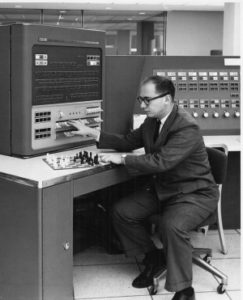
1958. Tennis for Two: the first video game. Physicist William Higinbotham (Brookhaven National Laboratory (BNL), USA) designed a tennis game using a Donner Model 30 analog computer connected to an oscilloscope display. The computer could calculate ballistic missile trajectories. This allowed two players with special controllers with an adjusting knob and “fire” button, to play a game of ‘tennis’ on the oscilloscope screen, with the “light trace” for the ball. Pressing the button hit the ball, and turning the knob controlled the angle of the shot. The game was rendered as a horizontal line, representing the tennis court, and a short vertical line in the center, representing the tennis net. The ball was launched by the first player and could hit the net, go out of bounds or hit the ground. The other player could hit the ball back using the other controller and if hit a sound was made. In later versions the gravity acting on the ball could be adjusted.
1959. At MIT Steve Russell, Martin Graetz and Wayne Wiitanen, design a space battle game called Spacewar! on a PDP-1 computer. It was a two-player game, with each “starship captain” controlling a spaceship amidst a speckled deep space background while attempting to destroy the other with lethal torpedoes. A pulsing star in the center of the screen attracted both ships requiring maneuvering to avoid dropping onto the star. The players could use an emergency escape into hyperspercae and reappear at random. You can find a video on You tube.
1960s. Writing Games Becomes Easier.
1964. John Kemeny of Dartmouth College (USA) creates the BASIC programming language, making it easy for many to write computer games. Soon, countless games are being created. Books with Basic programs appeared, like David Ahl’s book, allowing you to program a game on your home computer. The result was maybe not as cute as on your smartphone, but then there was the excitement and you could easily tweak the game…
1966-69. It is worth mentioning the introduction of electromechanical arcade games by Sega and Taito in Japan. In 1966 Sega introduced an electro-mechanical game called Periscope – an early submarine simulator and light gun shooter which used lights and plastic waves to simulate naval warfare with ships sunk by submarine. In 1967 Taito released its electro-mechanical arcade game: Crown Soccer Special, a two-player sports game that simulated association football, using various electronic components, including electronic versions of pinball flippers. The games became hugely successful both in Japan, Europe and North America. In Sega 1969 released a vehicle-combat simulation Missile, which featured electronic sound and a moving film strip to represent the targets on a projection screen. It was also the earliest known arcade game to feature a joystick with a fire button.
1967. Ralph Baer and his colleagues at Sanders Associates, Inc. developed a prototype for the first multiplayer, multiprogram video game system: TV Game Unit #7, better known as the “The Brown Box”, because of its colour. The “Brown Box,” had basic features of video games consoles today: two controls and a multigame program system. It could be programmed to play different games by positioning switches on the front of the main unit. The games included ping-pong, checkers, sports games, target shooting with the use of a lightgun and a golf putting game, which required the use of a special attachment. Sanders licensed the “Brown Box” to Magnavox, which released the system as the Magnavox Odyssey in 1972.
1969. Following the NASA Apollo XI mission, a student Jim Storer created the Lunar Lander game for the PDP-8 computer, written in the FOCAL programming language. Variations were made for other computers. It was rewritten in Basic and included in David Ahl’s Basic game book. It became an arcade game.
1970s. The Beginnings of the Industry. The first arcade machines appeared. They were expensive, but viable commercially and helped make computer games feasible popular. The decade saw appearance of the first home video consoles, handheld consoles and the introduction of microprocessors.
1970. The Scientific American published the rules of the game of Life devised by the Cambridge University mathematician John Horton Conway in Martin Gardner’s “Mathematical Games” column.The game requires a large checkerboard and flat black and white counters. The counters (one to a cell) play the role of organisms that live or die according to neighbourhood laws laid out by Conway, that correspond to under or overpopulation, including the possibility of birth. Many implementations of this game were soon made for computers.
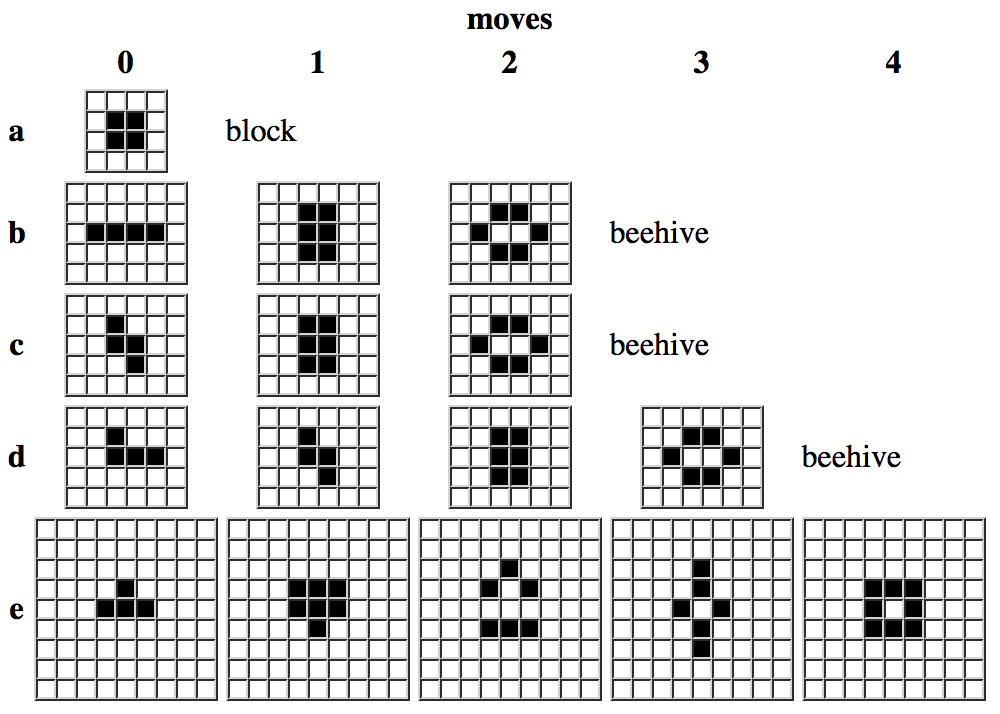
1971. The prelude to Computerised Arcade Games In the Soviet Union … Electromechanical arcade game machines appeared In the USSR following an exhibition of western products «Аттракцион-71» (Attraction-71) in 1971 in Moscow. Strangely (or perhaps not) these were manufactured by military factories, which were supposed to also produce objects for civilan consumption. These arcade games included : «Морской бой» Naval Battle, «Магистраль» Highway, «Городки», Towns, «Снайпер» Sniper, «Баскетбол» – Basketball.
1971. Atari founder Nolan Bushnell with Ted Dabney designed Computer Space in collaboration with Syzygy Engineering. The game was a derivative of Spacewar!. It featured a rocket controlled by the player, engaged in a missile battle with flying saucers set against a background starfield. The goal is to score more hits than the enemy spaceships within a set time period. Bushnell designed futuristic coulurful fiberglass cabinets for the game.
1972. Allan Alcorn developed an arcade table tennis game for Atari: Pong, whose initial inspiration could be a tennis game of Magnavox seen by Bushnell. The system was installed in bars etc and featured a pay-slot mechanism for gaming access. The game was hugely successful and other companies soon followed suit.
1972. Magnavox, released a version of the Brown Box of Sanders they called the Magnavox Odyssey in 1972 (see consoles image above). The Odyssey only moved three squares and a vertical bar on the screen. The system for the first time could be connected to a home TV set! The game included different types of plastic overlays which clung by static electricity to to the TV screen, to create special visuals for the different game. The Odyssey was distrubted in Japan by Nintendo who secured the rights in 1974. This was Nintendo’s first venture into the video gaming industry.
1973-76. In 1973, Taito released Speed Race, an early driving racing game designed by Tomohiro Nishikado. The game featured a steering wheel controller, and overhead vertical scrolling, with changes of the course width as the player’s car moves up the road. In 1975 Nintendo moved into the video arcade game industry with EVR Race, designed by their first game designer, Genyo Takeda. In 1976, Sega released Moto-Cross featuring a three-dimensional perspective view and haptic feedback, which caused the motorcycle handlebars to vibrate during a collision with another vehicle.
1976. Fairchild Semiconductor stepped into the game with its Fairchild Channel F (F for Fun) home video game. The unit used Fairchilds F8 new CPU. Price of $169.95. It was revolutionary in that it introduced the use of programmable ROM cartridge–based video games, and was the first console to use a microprocessor.
1976. Texas Instruments created an educational toy: an inverse calculator “Little Professor” as a help in learning arithmetic. “Little Professor” would propose an expression to be solved like “4×5=.. ” and the user had three chances to give the correct answer. An incorrect answer resulted in an EEEE sound and if all answers were wrong the correct one was displayed.
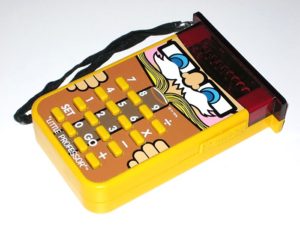
1975-77. Atari released its PONG console. In 1977 Atari introduced its 2600 Video Computer System appears featuring joysticks, interchangeable cartridges, games in colour, and switches for selecting games and setting difficulty levels. The first system had only 1 Kilobyte of memory for both the program (written in Assembly language) and the data. The VCS 2600 had a resolution of 192×160 pixels. Within a few years with improving hardware and game quality, with a number bundled in, the VCS 2600 became one of the most popular game consoles selling over 30 million units.
1976-78. The first handheld game console was introduced by Mattel, with a single game the Auto Race. The console was an evolution of the optoelectronic calculators that had started appeared in the preceding years. The Mattel console used light emitting diodes (LEDs). The race was folowed by Electronic Football (1977). In 1977 Nintendo began to produce its own Color TV-Game home video game consoles. In 1978 Coleco introduced its Electronic Quarterback.
1978. The US Texas Instruments introduced its famous “Speak and Spell” educational console. It was advertised as a tool for helping children ages 7 and up to 12 to learn to spell and pronounce over 200 commonly misspelled words. The initial unit had a vacuum fluorescent display where typed words appeared. There was a provision for cartridges. The unit had a specially designed TMC0280 linear predictive coding speech synthesizer (later named TI TMS5100) and is famous precisely because of this speech synthesis unit, which had a significant influence in this field. It was the first low-cost, mass produced unit which produced speech electronically and not by pre-recording. Each word was represented by a series of phonemes and the data was stored in ROMs. The unit was frequently bought for its speach synthesizer. Speak & Spell was named an IEEE Milestone in 2009. The unit was later sold for other languages and its various versions were in production till 1992. “Speak and Spell” has been used in music as an instrument directly or with some modifications (with so called circuit bending). It has also appeared in TV shows and films like Steven Spielberg’s E.T. the ExtraTerrestrial or Pixar’s Toy Story.
1980s. The Crash and Games Proliferation. The game console market crashed in the US and was then strongly developed in Japan. Appearance of inexpensive personal computers played a role in the disaffection for consoles. personal computers had better memory, graphics and sound capabilities. Amongst the more popular in this sense were probably the Tandy Radio Shack’s TRS-80, the Commodore VIC-20, the Sinclair ZX80, the Commodore 64 and the Atari ST. Many more games could be played on computers because of existence of cassette tapes and later floppy disks. The computers offered greater flexibility in that games could be saved at some point and continued later.
Many now well known games were produced in this decade, like Zork and Pac-Man (1980), Donkey Kong (1981), Pole Position (1982), Pitfall (1982), Mario Bros. (1983), Dragon’s Lair (1983), Tetris (1984), King’Quest (1984), Elite (1984), The Legend of Zelda (1986), Metroid (1986), Mega Man (1987), Final Fantasy (1987), Metal Gear (1987), Popoulos (1989) and Prince of Persia (1989).
1980. Texas Instruments introduced its “Speak & Read” and “Speak & Math” educational consoles as a sequel to “Speak and Read”.
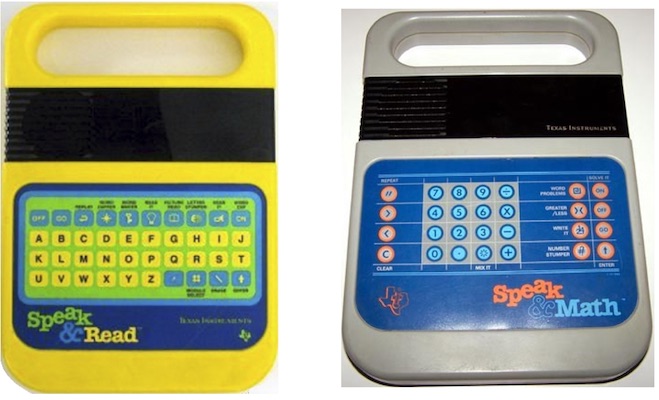
1980. Japanese Namco produced the immensely popular game Pac-Man,created by famous Toru Iwatani. Iwatani was apparently inspired by seeing a pizza with a missing slice. Pac-Man is considered one of the classics of the medium, and an icon of 1980s popular culture. It has found a place in the Smithsonian Institution and the New York Museum of Modern Art. It had generated more than $2.5 billion by the 1990. In 1982 Mrs. Pac-Man appeared. Pac-Man was ported to the Atari 2600 and since then many other platforms.
1980-82. Nintendo launched the Game & Watch handheld video game series, starting with Ball, developed by Gunpei Yokoi. The device included a watch and an electronic game. The “cross” D-pad design was added in 1982, by Yokoi for the Donkey Kong version. The design earned a Technology & Engineering Emmy Award.
1981. Nintendo produced its major arcade hit: Donkey Kong, invented by Shigeru Miyamoto. In this platform genre game the main character, the now famous Mario (originally named Mr. Video and then Jumpman) is manoeuvred across a series of platforms in his effort to rescue Pauline from the giant ape Donkey Kong. The game was ported to the Game and Watch console.
1983. In Japan, Nintendo and SEGA introduced their home video game systems the Famicom (Family computer) (8bit Ricoh’s 2A03, MOS Technology 6502 like processor) and SG 1000 (3.58 MHz, Z80 CPU) respectively. The Famicom is also known as the Nintendo Entertainment System (NES). Nintendo’s system was introduced in the USA in 1985 and Europe in 1986, with some variations. In 1985 Nintendo introduced the Robotic Operating Buddy accessory for the Famicom/NES. The “robot” received comands as flashes from a CRT monitor and could be comanded to execute a few operations with its hands.
1984. The Russian mathematcian Alexey Pojitnov designed the famous dynamic puzzle: Tetris. In Tetris one needs to manipulate falling Tetriminos: geometric shapes composed of four square blocks each, with the aim of creating a horizontal line of ten units without gaps. There exist a number of clones. Electronic Gaming Monthly‘s 100th issue placed Tetris in first place as “Greatest Game of All Time”. It exists on most platforms and is one of the, if not the most dowloaded games on mobile devices today.
1986. The first Soviet computer arcade game: Konek Gorbunok. In 1986 the production of computerised electronic gaming machines was entrusted to the defense factory “Terminal” in the city of Vinnitsa in Ukraine, which had its own research and development center and produced displays. The Terminal engineers, headed by Alexander Gonorovsky, produced a 16bit CPU arcade game machine that could play a variety of games. The machine, cutely named TIA-MT1 (TИA-MЦ1), which stands for series or the Color Multiframe Television Game Machine (Телевизионный Игровой Автомат Многокадровый Цветной). The production of these machines was later done in Soviet Lithania by the enterprise «Сигма» (Sigma). The display featured 32 colour 256×256 pixel graphics, quite advance for that Soviet time. The game programmes were developed by the Ukrainian Extrema company (Экстрема-Украина). The first arcade was designed following the famous Russian story Konek Gorbunok: The Little Humpbacked Horse, written by Pyotr Pavlovich Yershov (1815-1869). Besides Konek Gorbunok eleven other games were produced : «Снежная королева»- The Snow Queen, SOS, «Кот-рыболов»-Fisherman-cat, «Звездный рыцарь»- Star Knight, «Истребитель»- Fighter Plane, «Котигорошко»-Kotigoroshko, «Остров дракона »- Dragon Island, «Остров сокровищ»-Treasure Island, «Автогонки»-Auto Racing, «Бильярд»-Billiards and «Городки»-Towns. Most of these arcade machines have disappeared but some were found and exhibited in the Russian Arcade Museum founded by Aleksandr Stakhanov and Maksim Pinigin. The above information and images are from the museum.
1989. Nintendo introduced the Game Boy, with removable game cartridges. It was powered by an 8 bit, Intel 8080 like, 4MHz Sharp processor and had 8kb of SRAM and 8kb of video RAM. The display was 160×144 pixel STN LCD. The unit was designed by Satoru Okada. It came bundled with Tetris, which added to its appeal. Numerous game cartridges for the Game Boy were produced. Along with the later Game Boy colour around 120 million units were sold.
The Game boy was soon followed by the less successful Sega Game Gear and the Atari Lynx.
1989-90. SEGA introduced its Mega Drive (Genesis) followed in 1990 by the Nintendo’s Super NES (aka Super Nintendo). These were 16bit processor based systems. SNES was introduced in the following years in other countries. SNES had advanced graphics and sound capabilities compared with other systems at the time.
1990s and beyond.
With passing years we have witnessed the appearance of more and more powerful game consoles equipped with 32, then 64 and (post 2000), 128 bit processors, very large memories and with enhanced graphics capabilities especially moving towards 3D graphics. There appeared new players in the game, notably Sony with Play Station (1994) and later Microsoft with its X Box (2001). Microsofts 1995 introduction of Direct-X allowed developers to abstract from the graphics hardware and boosted the developments of Windows games.
The appearance of modems and spread of the Internet access led to the rise of multiplayer online role playing games (MORPG), which were primarily the domain of the PCs. One of the famous games in this line is the World of Warcraft (2004). A revolution occurred following introduction of the Apple iPhone in 2007 that had a huge influence on Mobile gaming. Mobile gaming has developed immensely since then with the introduction of the iPAD, Android and Microsoft devices.
A significant change was in the introduction of devices that react to body movement. Amongst the first was Sega’s Activator peripheral for the Genesis/Mega Drive. The player would stand in the middle of an octagonal ring, which emitted infrared light beams directly up, and sensed their reflections back from the ceiling. The player’s movements over each section would cut the beams and trigger some form of action necessary for the game. Beams could be cut high by hands or at floor level by feet, producing sixteen distinct inputs. This follows the laser harp principle as used by musicians like Jean Michel Jarre since the early 1980’s.
A decade after Sega Nintendo introduced its Wii system in 2006. The controller registered player movements which were then used to steer the game. Microsoft responded by introducing Kinect for XBox 1 in 2010. Kinect, equipped with a small video camera enabled users to control and interact with their console or computer using gestures and spoken commands. Also in 2010 Sony released its Move motion sensor system for the Play Station 3.
Virtual reality in gaming has been an old dream. Virtual reality artificial 3-D environments are created with VR software. They allow the user to live an emotionally different experience. The crudest VR game involve a 3-D image that can be explored by via a keyboard or musing, mouse or touchscreen. More sophisticated and immersive examples require use of VR headsets, wrap-around display screens and VR rooms augmented with wearable computers and sensory components, such as scents and haptics devices for tactile feedback. These are still fairly new but rapidly spreading.
Artificial Intelligence and Robotics. Use of artificial intelligence approaches is bringing more and more changes. Perhaps the most striking aspect today is that computers have become unbeatable at games of strategy.
1994. CHECKERS. Chinook, a program by J.Schaeffer, won the title “Man-Machine World Champion” from Marion Tinsley. In 2007, brute-force computer analysis managed to examine all 500 billion billion (5×1020) possible board positions, and generate a file which contained full information on every position that can arise during the game, and which move, would lead to a win or a draw in that position.
1997. CHESS. IBM’s DeepBlue (then 259th supercomputer on TOP500 list) beat World Champion Garry Kasparov. It was a highly parallel 30 node machine able to evaluate 200 million positions/second. In 2006 Deep Fritz beat world champion Vladimir Kramnik. The program ran on a computer system with only a dual-core Intel CPU, evaluating only 8 million positions per second, but using a different algorithm. In 2017, DeepMind’s self taught AlphaZero defeated world-champion programs, Stockfish(chess) (and elmo with shogi game engine). AlphaZero’sinitial training was via “self-play” using several thousand processing units to generate the games and train the neural networks, all in parallel, with no access to opening books or endgame tables. It took just 9 hours to train. The trained algorithm played on a single machine with four processing units when beating Stockfish.
2016, GO. DeepMind’s AlphaGo beat Go’s world champions Lee Sedol and in 2017 Ke Jie. AlphaGo uses a Monte Carlo tree search algorithm to find its moves based on knowledge previously “learned” by machine learning. An artificial neural network was extensively trained, both by human and computer play.
Robotic Toys. We also witness the appearance of small robots as toys that are preprogrammed or can be programmed at will by the player, an evolution due to the spread of very cheap computer boards like Arduino or the Raspberry Pie and development of teaching of programming using e.g. Blockly or Scratch. Some of these are Cloud connected via Wi-Fi so they are learning and updating with new skills and features. In the image below some coding robots from left to right : Wonder Workshop Dash Robot, Anki Vector, SmartGurlz Maria and Mblocks DIY Mecano type Robotic Kit with lots of addons.


